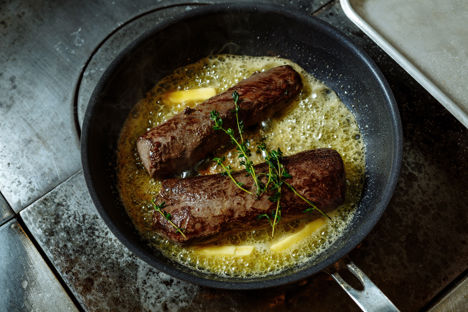Venison can be a divisive meat, loved for its distinctive flavour by as many people who dislike it for the same reason. It can have a bad reputation for being tough but, if carefully sourced and correctly handled, this is a regal meat that surpasses all others. It is also one of the most ethical meats that the UK has to offer so it could well be time to tuck in.
What to look for when buying venison
In terms of animal welfare, both farmed and wild venison tend to come up trumps in comparison to other game and meat. It can even be argued that farmed venison in the UK is even more of an ethical choice than wild venison. Many farms (where deer are free to roam around grazing in herds) sell their own meat in on-site farm shops, meaning a shorter supply chain. Deer are shot in the pasture where they spend their lives so do not have to travel to an abattoir before slaughter– a major factor in reducing stress in the animal which gives even tastier meat.
The majority of wild venison come from herds culled to keep numbers down which is a routine part of countryside management. The deer are not shot to produce the best meat but rather for pragmatic reasons which means that there may be a lot of variation in texture and quality from deer to deer.
Younger deer tend to produce more tender meat though hanging and ageing of the meat and the stress levels at slaughter will have a major impact on the flavour and texture so don’t reject an older deer immediately.
The 'venison season' varies depending on the type and sex of deer hunted and where you are in the country but generally, you will see it for sale from late summer to late winter.
The appearance and taste of venison will vary dramatically depending on the age of the deer and how long it has been hung. Depending on the diet of the deer, the meat may have a subtle taste of juniper or sage, and there are variations in flavour depending on the species. For example, the meat of the mighty red deer has a richer, bolder flavour than the more delicately flavoured roe or fallow. Hanging venison develops the flavour of the meat, and produces more tender meat. Ask your butcher or game dealer about hanging time and variety of venison that you are being sold.
How to cook venison
Before cooking venison, it is important to recognise the ways in which venison differs from other meats. Perhaps most important is the issue of fat content: while its leanness makes venison increasingly popular among health-conscious diners, its lack of fat makes it susceptible to dryness. Furthermore, venison fat, unlike pork or beef fat, does not taste pleasant. For most meats, the fat is what gives it a distinctive flavour and deliciousness. With venison, other animal fats need to be used in some cases to keep the meat moist and create a rounder flavour.
Venison cuts suited for slow cooking mainly include shoulder and leg, as well as meat from older animals. These cuts should be cooked whole or diced and browned prior to cooking. Venison is also often marinated for up to 24 hours before slow cooking to cut through the rich flavour and help to tenderise the meat. Take care with marinade choice, though, – you don’t want to completely mask the flavour of the meat.
Venison stew is a wonderfully wintry dish – simply braise some browned, cubed venison shoulder or leg with vegetables in a combination of stock and wine for at least 5 hours in a low-medium oven; the meat should be wonderfully tender.
Venison also makes a flavourful charcuterie meat – Emily Watkins uses venison to make a delicious salami.
Prime cuts, such as venison loin fillets or saddles, can get away with very little cooking. These tender cuts benefit from a medium-rare finish to make the most of their finer texture. Paul Ainsworth pushes the boundaries and serves loin of venison raw in this carpaccio.
Simon Haigh’s Venison Bolognese or Josh Eggleton’s Venison burger make wintry adaptations of classics but you need to make sure the lean mince doesn't dry out. Mince is sometimes ground by the butcher with fat or you may need to add your own. Josh Eggleton adds bacon to his burgers to keep them moist. Simon Haigh cooks the mince in clumps which means some pieces of meat are well browned and highly flavoured while others are less well cooked and have a softer texture.
What venison goes with
The flavour of venison lends itself well to earthy, autumnal flavours like mushroom, turnip, beetroot and parsnip. Juniper is frequently paired with venison to provide a fresh evergreen aroma to match up to the gamey flavour – see Graham Campbell's Venison loin with celeriac remoulade, pomme Maxine and juniper jus for a good example of this.
Chocolate and red meat have been paired together since Aztec times and the flavour of the bitter chocolate gives a rich, earthy note to the venison. Marcus Wareing includes dark chocolate and fig in his roast venison recipe.
For something a little different, try Simon Rogan's recipe – he cooks venison leg in hay and pairs it with sweet and aromatic red cabbage and roast celeriac. Check out our venison collection for more recipes.
Get in touch
Please sign in or register to send a comment to Great British Chefs.



